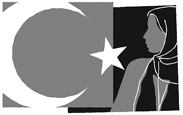Veiled meaning
"Religion has always been in politics," said Professor Jeremy Gunn in his talk, "Unveiling Sahin: The European Court Decision on the Islamic Head Scarf." Professor Gunn came from Emory University to speak at the Nahum Gelber Faculty of Law on November 10. "World politics has seen a resurgence of religious involvement ever since the 1979 Islamic revolution in Iran." Islam has over one billion adherents worldwide and is, according to some sources, the fastest growing religion in the U.S. and in the European Union.

Tzigane
The Islamic head scarf is an important sign of modesty for many Muslim women, but last year, France banned the wearing of the head scarf in public schools. Guided by the concept of laïcité, or state secularism, this ban purported to safeguard rights and equality. In a continuation of this trend, the European Court of Human Rights handed down a decision on Leyla Sahin vs. Turkey in June 2004, supporting a Turkish ban on head scarves in universities.
The case was brought to the European Court of Human Rights by Leyla Sahin, a Muslim student enrolled in an Istanbul medical school who was denied admission to exams, lectures and courses when she refused to unveil. She filed a suit against the school and lost, but her appeal eventually reached the European Court of Human Rights in Strasbourg. During this time she had to move to Vienna in order to continue her studies.
It took the court almost five years to make their decision, which Professor Gunn called "one of the worst decisions, perhaps the worst, that I have read from the European Court of Human Rights." Although the court acknowledged that banning the head scarf constituted a violation of Sahin's right to religious expression (outlined in Article Nine of the European Convention on Human Rights), it claimed that the curtailment of this right was justified and necessary in the Turkish context, upholding the ban as a necessary measure to protect secularism, gender equality and democracy.
Professor Gunn maintained that the court did not properly examine Turkey's social context, only superficially considering the complex and often coercive relationship between the military and the government in the past 25 years. He stated that "to the government [and the military], the head scarf is the symbol of militant Islamism." The government's fear of militant religious movements has caused it to take pre-emptive measures toward the extreme of secularism.
Gunn accused the European Court of being either "ignorant or complicitous" in perpetuating the harshly secular military legacy and allowing the state to decide, "in its infinite wisdom, that people can't make decisions for themselves." There was no evidence of political motivation on Sahin's part; a religious Muslim, she had worn the head scarf for many years. Gunn alleged that by essentially banning religious Muslim women from universities, the state is violating the principle of gender equality and the right to education.
The case of Sahin vs. Turkey raises questions about the attitude of secular states toward Islam and other religions. With Islam in the world's spotlight, it is difficult, yet necessary, for states to distinguish between incendiary symbols and legitimate religious expression. According to Gunn, the head scarf is "not a little issue — it is the symbolic issue" when it comes to religion and politics, and this decision will form a precedent for future decisions on religious rights.
